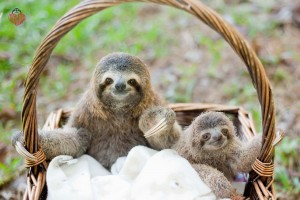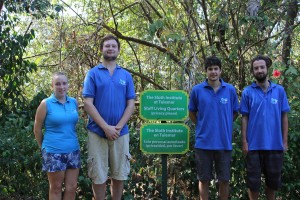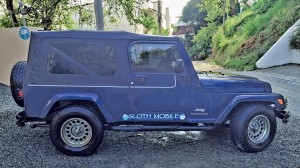All About #slothlove—The TSI story
 About The Sloth Institute, Costa Rica
About The Sloth Institute, Costa Rica
By Seda Sejud, Chief Sloth Ambassador at TSI
You may have seen the Sloth Mobile driving around town, or you may have seen some young people walking in Manuel Antonio wearing the shirts you see pictured here and wondered, who are these people and where did they come from? What is hashtag slothlove? What is a sloth mobile? And who/what is The Sloth Institute Costa Rica and where did they come from?
By the time you finish reading this article, we hope that you, our community members and the tourists who come to visit our beautiful Manuel Antonio, know more about who we are, what we are doing and how you can help keep our Manuel Antonio #BornToBeWild.
 The Sloth Institute, founded in August 2014 near Manuel Antonio, Costa Rica by Sam Trull and myself, initially operated as a branch of Kids Saving the Rainforest. Sam had spent two years caring for and rehabilitating sloths at KSTR, a non-profit organization dedicated to the rescue and rehabilitation of wildlife and to raising awareness of the importance of saving rainforests. During Sam’s time at KSTR she realized not only her passion for working with sloths but also the need to understand more about these amazing creatures that were coming into the rescue center as abandoned babies in record numbers so that more could be done to protect them. She communicated this passion to me and the rest is, as we like to say, sloth “future”.
The Sloth Institute, founded in August 2014 near Manuel Antonio, Costa Rica by Sam Trull and myself, initially operated as a branch of Kids Saving the Rainforest. Sam had spent two years caring for and rehabilitating sloths at KSTR, a non-profit organization dedicated to the rescue and rehabilitation of wildlife and to raising awareness of the importance of saving rainforests. During Sam’s time at KSTR she realized not only her passion for working with sloths but also the need to understand more about these amazing creatures that were coming into the rescue center as abandoned babies in record numbers so that more could be done to protect them. She communicated this passion to me and the rest is, as we like to say, sloth “future”.
In September 2015, The Sloth Institute Costa Rica was established as its own legal non-profit entity to facilitate our vision of expanding scientific knowledge and education about sloths, both captive and wild, in order to enhance their well-being and assure their conservation. The Sloth Institute continues to work closely with Kids Saving the Rainforest here in Manuel Antonio; with their sloth rescues and with reintroducing their hand-raised sloth orphans back to their natural habitats.
The Sloth Institute’s 3-part mission is:

- Research of captive and wild sloths.
- Collaboration with other institutions that work with sloths
- Education to generate and disseminate responsible and balanced information about sloths to the public.
As a result of the generosity and benevolence of Tulemar Resort (Tulemar Vacation Homes and Buena Vista Luxury Villas) who aided in the building and funding of the release cage and housing project for the TSI team, The Sloth Institute is located within Tulemar’s maritime zone ( in Manuel Antonio). The group of 5 amazing research team volunteers, including Sam, are monitoring four sloths (two of which had been hand raised by Sam since they were 1-2 weeks old; the other two since they were months old) that are slowly being reintroduced to the rainforest. Our international team of volunteer researchers, 2 from the UK, 1 from Spain and 1 from Canada, live, eat and breath sloths and have committed to the the work from 6 months to a year or longer. The team members are all young, educated people who love wildlife (sloths in particular) and are passionate about preserving the planet and the species. It’s their dedication and commitment that inspires me to help this wonderful team.
The four sloths, (Ellen, Kermie, Monster and Piper) are residing in a 6 by 6 by 6 meter tall, non-permanent soft release cage specially designed and constructed for this ambitious release program, located in a secluded section of the maritime zone where humans are not allowed. The sloths were introduced to the MINAE approved cage in September and have been acclimating to their new environment surrounded by a variety of their favorite edible trees and vines. This past month, the cage doors have been opened at night so the first duo (Ellen and Kermie) can venture out and return; with the end goal being a final departure back home where they belong. The team will be tracking them 24/7 with the aid of VHF tracking collars over the course of two years to study their progress while simultaneously tracking and studying the wild sloths in Tulemar for comparison. We hope to extend this work outside the Tulemar maritime zone in the near future as well as assist other sloth rescue and rehabilitation centers with their release efforts.
The Sloth Institute also collaborates with the Cincinnati Zoo and Botanical Gardens which has helped provide funds for the tracking collars.
Thank you to Tulemar Resort, our sponsors, our amazing volunteer research team, KSTR, Dra Maria Pia Martin, our virtual and local volunteers, our donors and of course to the sloths! A special shout out to Agua Azul, Emilio’s and Café Milagro for providing a meal a week to our volunteer team of 5 research members. If you are a restaurant located in MA and would like to participate, please let us know. We couldn’t do this without all of you.
#slothlove #BornToBeWild
Get Involved
If you would like to help the sloths return home to the rainforest where they belong, you can participate in The Sloth Institute’s Adopt-a-Sloth program or donate to their fundraising campaign to help give sloths a second chance at life in the rainforest at tsi.charity.org.
TSI is fiscally sponsored by Global Impact/Charity.org allowing US donors to receive a 501c3 deduction for their donations and has corporate matching opportunities.
Planning a trip to the States? Or have them sent to someone coming to CR? Check out TSI’s wishlist on Amazon (under The Sloth Institute wish list) for much needed items.
*Stay abreast of TSI news by liking their FB page (The Sloth Institute) and signing up for their newsletter www.theslothinstitutecostarica.org
The Sloth Institute is currently building out its International Advisory Board team. For more information contact info@theslothinstitutecostarica.org.
Be on the lookout for a community event in May to be held at Z Restaurant, featuring Sloth Trivia and meet the research team.
 Sam Trull has been featured on the BBC’s Natures Miracle Orphans—a 2-part series that documented efforts to raise baby sloths at Kids Saving the Rainforest. She is a soon to be published author of the book Slothlove, available at Barnes and Noble. The Sloth Institute was also involved with the first ever Caesarean section performed on a pregnant sloth that had been injured after falling from a tree. Sam also drives the sloth mobile.
Sam Trull has been featured on the BBC’s Natures Miracle Orphans—a 2-part series that documented efforts to raise baby sloths at Kids Saving the Rainforest. She is a soon to be published author of the book Slothlove, available at Barnes and Noble. The Sloth Institute was also involved with the first ever Caesarean section performed on a pregnant sloth that had been injured after falling from a tree. Sam also drives the sloth mobile.
